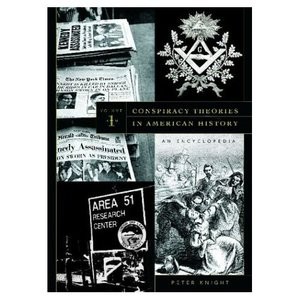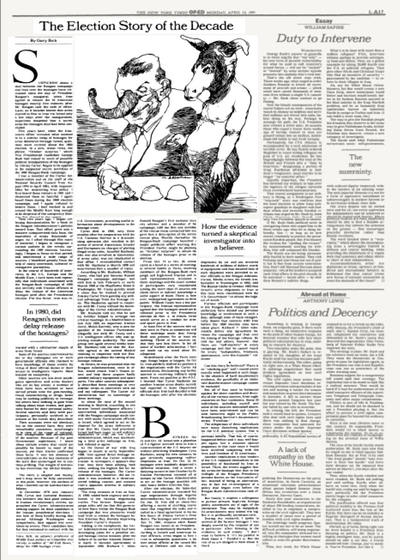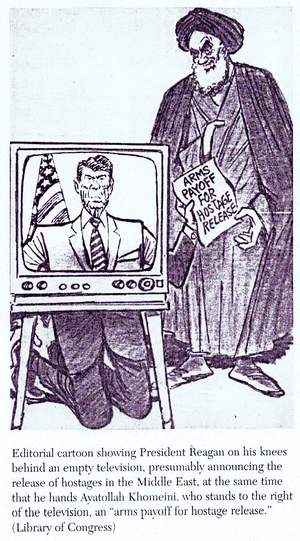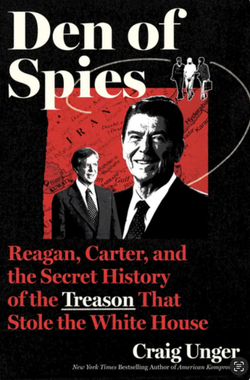Published in Conspiracy Theories in American History: An Encyclopedia, ed. Peter Knight
Santa Barbara, Calif.: ABC-Clio, 2003
Vol. 2, pp. 547-50
 The October Surprise conspiracy theory holds that in October 1980, Ronald Reagan conspired with the Islamic Republic of Iran to beat Jimmy Carter in the U.S. presidential elections on 4 November. The deal: in return for the Khomeini government keeping its U.S. hostages at the U.S. embassy in Tehran until after the election, damaging the Carter's candidacy, Reagan would reward it with armaments. The conspiracy theory endured for over a decade, 1980-93, but has since disappeared.
The October Surprise conspiracy theory holds that in October 1980, Ronald Reagan conspired with the Islamic Republic of Iran to beat Jimmy Carter in the U.S. presidential elections on 4 November. The deal: in return for the Khomeini government keeping its U.S. hostages at the U.S. embassy in Tehran until after the election, damaging the Carter's candidacy, Reagan would reward it with armaments. The conspiracy theory endured for over a decade, 1980-93, but has since disappeared.
The idea originated with Lyndon LaRouche, one of the most prolific, original, and bizarre of U.S. conspiracy theorists. Just after the 1980 election, one LaRouche magazine (Executive Intelligence Review, 2 December 1980) first laid out the conspiracy theory, then another one repeated it three years later (New Solidarity, 2 September 1983). The idea attracted minimal attention, however, until the Iran-Contra scandal of late 1986 seemed to fulfill the terms of the alleged deal. The former president of Iran, Abol Hassan Bani Sadr, tentatively tried out this theory in an article on 12 April 1987 in the Miami Herald. When commentators in the United States (Christopher Hitchens in particular, writing in The Nation, 4-11 July 1987) endorsed the idea, Bani Sadr felt emboldened to make ever-larger and more elaborate claims (the New York Times, 3 August 1987; the Miami Herald, 9 August 1987; and an August 1987 interview [Cockburn, 192-3; 281]).
A handful of conspiracy theorists in the United States (Barbara Honegger, Martin Kilian, David Marks, Robert Parry, Jurgen Roth, and Craig Unger) began researching Bani Sadr's allegations and stumbled upon an array of self-promoters, con men, and criminals from several countries. The cast included Israelis (Ari Ben-Menashe, Ahran Moshell, and Will Northrop), Frenchmen (Robert Benes and Nicholas Ignatiew), Iranians (Jamshid Hashemi, Ahmed Heidari, Houshang Lavi, Hamid Naqashan), Americans (Richard Babayan, Richard Brenneke, William Herrmann, Oswald LeWinter, Heinrich Rupp and Gunther Russbacher), and even a South African (Dirk Stoffberg). Not only did they confirm the story and add their own elaborations, but the researchers carelessly contaminated their sources by informing them of others' statements, further stimulating them to grandiose claims.
After a year, Bani Sadr returned to the topic and found his conspiracy outline fully fleshed out; he was especially impressed by Brenneke's allegations at a 1988 trial in Denver, which in his eyes offered official documentation of the plot. Encouraged by this new information, the former Iranian president now hypothesized a much larger and longer-lasting conspiracy between Reagan and Khomeini (Playboy, September 1988; and the interviews he granted to Jean-Charles Deniau in September and October 1988, forming the basis of their joint book [Deniau and Sadr, 48; 57]).
 The New York Times oped page, 15 April 1991. |
The October Surprise instantly vaulted to national importance. Leading television shows devoted hours to the subject, weeklies made it the subject of cover stories, and Jimmy Carter called for an investigation. A January 1992 poll showed 55 percent of Americans believing these allegations to be true and just 34 percent finding them false (Goertzel, 733). As part of his preparations to run for the presidency, H. Ross Perot sent his associates to talk with Gunther Russbacher in his Missouri jail cell. In February 1992, the House of Representatives voted in favor of an investigation of the charges and the Senate followed suit soon after.
Sick himself expanded his op-ed into a 278-page book, October Surprise: America's Hostages in Iran and the Election of Ronald Reagan. Here, Sick characterized the 1980 election as a "covert political coup." To give his story the feel of authenticity so important to a conspiracy theory, he chronicled in loving detail events that (it turned out) never took place. Thus, discussing a phantom meeting in Madrid on 27 July 1980, for example, he provided this little touch: "The conversation was interrupted twice, when hotel waiters arrived to serve coffee" (Sick, 83).
So much attention to the October Surprise theory meant it had to be checked in sober and exhaustive detail, and under such scrutiny it promptly collapsed. Several journalistic investigations started the process, especially Frank Snepp, "Brenneke Exposed," Village Voice, 10 September 1991; John Barry, "Making of a Myth," Newsweek, 11 November 1991; Steve Emerson and Jesse Furman, "The Conspiracy That Wasn't," New Republic, 18 November 1991; and Frank Snepp, "October Surmise," Village Voice, 25 February 1992.
Two congressional inquiries then confirmed these conclusions. The Senate stated that "by any standard, the credible evidence now known falls far short of supporting the allegation of an agreement between the Reagan campaign and Iran to delay the release of the hostages" (Committee on Foreign Relations 1992, 115). The House report went further, declaring that "There was no October Surprise agreement ever reached." It found "wholly insufficient credible evidence" that communication took place between the Reagan campaign and the Iranian government and "no credible evidence" of an attempt by the campaign to delay the hostages' release. The report also expressed concern that "certain witnesses may have committed perjury during sworn testimony" (Committee of the Whole House on the State of the Union 53; 7-8; 239).
 Surprisingly, given that once started, conspiracy theories tend to live on indefinitely, this one did not. For once, research successfully discredited a conspiracy theory. Symbolic of this was that Oliver Stone decided not to make a movie on this topic. But a devout conspiracy theorist sticks to his guns and Sick continued to forward the October Surprise thesis, writing (New York Times, 24 January 1993) that the House report "does not lay ... to rest" his claims of campaign contacts with Iranians; and that it "leaves open the possibility" of Republican interference with the Carter administration's foreign policy negotiations.
Surprisingly, given that once started, conspiracy theories tend to live on indefinitely, this one did not. For once, research successfully discredited a conspiracy theory. Symbolic of this was that Oliver Stone decided not to make a movie on this topic. But a devout conspiracy theorist sticks to his guns and Sick continued to forward the October Surprise thesis, writing (New York Times, 24 January 1993) that the House report "does not lay ... to rest" his claims of campaign contacts with Iranians; and that it "leaves open the possibility" of Republican interference with the Carter administration's foreign policy negotiations.
The October Surprise episode holds much interest as a conspiracy theory case study. In particular, two features stand out: Gary Sick's having single-handedly transformed it from a story only taken seriously on the left-wing fringe into a credible mainstream claim; and the clarity with which it confirmed the conspiracy theorists' tendency to accuse others of what they themselves are doing. On this latter point: again and again, one finds that whereas the conspiracy theorists' accusations of collusion and illegal behavior were unsubstantiated, they themselves engaged in precisely such behavior. Examples include:
They claimed Casey and Bush pretended to be in the United States when they were in Paris and Madrid. Richard Brenneke, perhaps the single most important informant for the October Surprise thesis, claimed to be in Paris and Madrid when credit card receipts proved he was in Portland, Oregon.
They accused Reagan campaign officials of plotting to save their necks, when this is what the conspiracy theorists were doing; at least seven of them (Robert Benes, Richard Brenneke, Ahmed Heidari, Nicholas Ignatiew, Oswald LeWinter, Hamid Naqashan and Will Northrop) were implicated in a 1986 sting operation and the October Surprise offered a way to rehabilitate their reputations.
Sick, a former Carter Administration official, accused the Reagan campaign of secretly working out an arms deal with the Iranians. In fact, as Sick himself already disclosed in 1985, Jimmy Carter initiated such a deal.
Sick accused others of withholding information, yet this is precisely what he did, keeping quiet about the hundreds of thousands of dollars he received from Oliver Stone for the movie rights to the October Surprise story.
Sick accused U.S. government officials of lying, yet he was less than honest himself. He wrote in his New York Times article that he had heard rumors of a Reagan-Khomeini deal during the 1988 election campaign but he "refused to believe them." Not so: on 30 October 1988, at the very peak of the 1988 election campaign, he told The Rocky Mountain News, "At first I dismissed this, but not any more. I'm convinced on the basis of what I heard that there were some meetings in Paris."
References
- Cockburn, Leslie. 1987, Out of Control. New York: The Atlantic Monthly Press.
- Deniau, Jean-Charles, and Bani Sadr. 1989. Le Complot des ayatollahs. Paris: Editions la Découverte.
- Goertzel, Ted. 1994. "Belief in Conspiracy Theories." Political Psychology 15.
- Sick, Gary. 1991. October Surprise: America's Hostages in Iran and the Election of Ronald Reagan. New York: Times Books.
- U.S. House. 1993. Committee of the Whole House on the Steven Emerson, "No October Surprise", American Journalism Review (March 1993)
- State of the Union. Joint Report of the Task Force to Investigate Certain Allegations Concerning the Holding of American Hostages by Iran in 1980. Washington, DC: U.S. Government Printing Office.
- U.S. Senate. 1992. Committee on Foreign Relations. The "October Surprise" Allegations and the Circumstances Surrounding the Release of the American Hostages Held in Iran. Washington, DC: U.S. Government Printing Office.
Dec. 1, 2003 update: My main writings on the "October Surprise" conspiracy theory, in chronological order as they appeared:
- "Gary Sick's Same Old Song." My original reply to Sick's 1991 oped.
- "Review of October Surprise: America's Hostages in Iran and the Election of Ronald Reagan." Sick's oped metastasized into a book, published in 1991 and reviewed by me in 1992.
- "The Election Story of This Decade." My 1993 parody of the Sick thesis.
- "The October Surprise Theory." An encyclopedia entry summarizing the whole affair up to 2003.
- "Further on the October Surprise Conspiracy Theory." A weblog entry started in 2004 that deals with developments since then.
 In addition, I appeared with Bani Sadr and Sick (among others) on a raucous panel at The Phil Donahue Show titled "Did Reagan and Bush Delay the Hostage Release to Win the Election?" on May 15, 1991.
In addition, I appeared with Bani Sadr and Sick (among others) on a raucous panel at The Phil Donahue Show titled "Did Reagan and Bush Delay the Hostage Release to Win the Election?" on May 15, 1991.
Oct. 1, 2024 update: I wrote above, in 2003, that "conspiracy theories tend to live on indefinitely, this one did not. For once, research successfully discredited a conspiracy theory." Well, for one dedicated conspiracy theorist, Craig Unger, it does live on. Today marks the publication of his book Den of Spies: Reagan, Carter, and the Secret History of the Treason That Stole the White House. Unger summarizes it thus in a note to the Gulf2000 group:
The book is the product of more than thirty years of research, on and off, in Iran, Israel, France, and Washington, into the secret collusion between Ronald Reagan's 1980 presidential campaign and Iran, otherwise known as the October Surprise.
In addition to corroborating reporting by Gary Sick and the late Robert Parry, Den of Spies reveals for the first time how one of America's most dazzling spies, Reagan-Bush campaign manager William Casey put together a treasonous multipronged covert operation—with cutouts, double agents, freelance arms dealers, Israeli operatives, and operatives from all over the world—to prolong the captivity of the American hostages held by Iran, and thereby undermine Jimmy Carter's bid for reelection in 1980.
